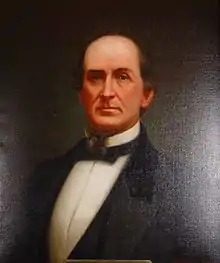Robert M. Patton
Robert Miller Patton (July 10, 1809 – February 28, 1885) was the 20th Governor of the U.S. state of Alabama from 1865 to 1868.[1]
Robert M. Patton | |
|---|---|
 | |
| 20th Governor of Alabama | |
| In office December 13, 1865 – July 24, 1868 | |
| Preceded by | Lewis E. Parsons |
| Succeeded by | William Hugh Smith |
| Personal details | |
| Born | Robert Miller Patton July 10, 1809 Russell County, Virginia |
| Died | February 28, 1885 (aged 75) Florence, Alabama |
| Political party | Whig |
Patton was born July 10, 1809, in Russell County, Virginia. His family moved to Huntsville, Alabama, in 1818 where Patton attended Green Academy. Patton apprenticed in the family cotton mill founded by his father William. In 1829 he moved to Florence, Alabama, and began a mercantile business that his sons took over in the late 1850s. He married Jane Locke Braham of Huntsville on January 31, 1832. They had nine children. Seven of his children lived to adulthood but he lost two sons, both Confederate soldiers, during the Civil War.
Patton's political career began in 1832 when he was elected to the state legislature. He was elected to the special legislature that convened in 1837 in response to the financial panic and depression of that year. Although he was a Whig, Patton continued to serve in one branch or the other of the state legislature until the outbreak of war. He represented the state at the national convention in Charleston, SC, in 1860 and was present at the secession convention in Montgomery. Patton opposed secession but supported the state's efforts through time and money and as a commissioner for the Confederacy. By the war's end, he suffered not only the loss of his sons but the destruction of his estate in Lauderdale County.
Patton represented his county at the constitutional convention in September 1865. He was elected governor in November and inaugurated on December 13. Patton worked closely with the assistant commissioner of the Freedmen's Bureau, General Wager Swayne. He helped Swayne procure rations for the thousands of indigent families in the state. His greatest contribution was his success in reducing the state debt. He issued "Patton certificates" in 1867 to offset state expenses in anticipation of the collection in taxes.
Despite Patton's efforts, he was largely stripped of his authority in March 1867 when presidential reconstruction ended with the passage of the Reconstruction Acts by Congress. Major General John Pope was placed in charge of the Third Military District which included Alabama, Georgia, and Florida. Swayne continued as the commanding officer of Alabama. Patton was allowed to remain in office and draw his salary but he was mainly a figurehead who could do no more than make recommendations to Swayne. Patton was officially the head of the state until William H. Smith became governor in July 1868.
After his political career ended, Patton became involved in several commercial ventures to establish and build railroads in the state, notably the Alabama and Chattanooga Railroad. He also served as a trustee of several schools and colleges, including the University of Alabama. He was instrumental in rebuilding the university after it was burned by federal troops during the war.
Patton died on February 28, 1885, at his plantation, Sweetwater, near Florence. He was buried in Huntsville.
References
- "Alabama : Past Governors Bios". National Governors Association. Retrieved June 12, 2019.
External links
| Party political offices | ||
|---|---|---|
| Vacant Title last held by William S. Earnest |
Whig nominee for Governor of Alabama 1865 |
Succeeded by None |
| Political offices | ||
| Preceded by Lewis E. Parsons |
Governor of Alabama 1865–1868 |
Succeeded by William Hugh Smith |
